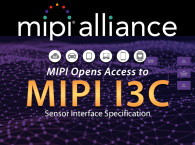
Released in January 2017, MIPI I3C v1.0 streamlines and advances interface technologies for connecting processors, sensors and many other devices that had previously used I2C (Inter-Integrated Circuit), the de facto standard for over 35 years. MIPI I3C is a bus interface for connecting sensors to an application processor. It is a core sensor integration technology that can combine multiple sensors from different vendors in a device to streamline integration and improve cost efficiencies. It gives developers unprecedented opportunity to craft innovative designs for any mobile product, from smartphones, to wearables, to safety systems in automobiles.
MIPI I3C can integrate mechanical, motion, biometric and environmental, and any other type of sensor. It incorporates key attributes of the traditional I2C and SPI interfaces to provide a new, unified, high-performing, very low power solution. The technology is implemented on a standard CMOS I/O. It uses a two-wire interface, which reduces pin count and signal paths to offer system designers less complexity and more flexibility. It can also be used as a sideband interface to further reduce pin count. MIPI I3C supports a minimum data rate of 10 Mbps with options for higher performance high data rate modes, offering a substantial leap in performance and power efficiency compared with previous options.
Additional technical highlights include multi-master support, dynamic addressing, command-code compatibility, and a uniform approach for advanced power management features, such as sleep mode. It provides synchronous and asynchronous time-stamping to improve the accuracy of applications that use signals from various sensors. It can also batch and transmit data quickly to minimize energy consumption of the host processor.
MIPI I3C Basic is a subset of MIPI I3C that bundles the most commonly needed I3C features for developers and other standards organizations. The mobile ecosystem and broader system integrator community can efficiently use these capabilities as an alternative to I2C. MIPI I3C Basic is available for implementation without MIPI membership and is intended to facilitate a royalty-free licensing environment for all implementers, as described within the specification.
MIPI I3C is developed by the MIPI Alliance Sensor Working Group. and the new Basic specification is developed by the MIPI I3C Basic Ad Hoc Working Group.
MIPI I3C Basic v1.0 provides 20 key features from MIPI I3C, including:
Backward compatibility with I2C
- A multi-drop bus that, at 12.5 MHz, is over 12 times faster than I2C supports while using significantly less power
- In-band interrupts to allow slaves to notify masters of interrupts, a design that eliminates the need for a separate general-purpose input/output (GPIO) for each slave and thus reduces system cost and complexity
- Dynamic address assignment to avoid conflicting static addresses, providing flexibility and pin savings
- Standardized discovery, and bus configuration and control
- Uses standard low-cost pads and requires minimal cost in logic to support
 “We have seen tremendous interest in I3C from the mobile ecosystem. Now, with I3C Basic, the broader developer community can immediately and efficiently begin using these capabilities as an alternative to I2C,” says Joel Huloux, chairman of MIPI Alliance. ”In addition, we are already working with several standards organizations to integrate I3C Basic into their specifications. We believe it provides tremendous value to mobile and many other industries in multiple ways. For example, as the IoT market expands, it will serve a growing need to transfer data collected from a wide range of mechanical, environmental, biometric and health sensors.”
“We have seen tremendous interest in I3C from the mobile ecosystem. Now, with I3C Basic, the broader developer community can immediately and efficiently begin using these capabilities as an alternative to I2C,” says Joel Huloux, chairman of MIPI Alliance. ”In addition, we are already working with several standards organizations to integrate I3C Basic into their specifications. We believe it provides tremendous value to mobile and many other industries in multiple ways. For example, as the IoT market expands, it will serve a growing need to transfer data collected from a wide range of mechanical, environmental, biometric and health sensors.”MIPI I3C Basic is available for implementation without MIPI membership and is intended to facilitate a royalty-free licensing environment for all implementers, as described within the specification. Companies interested in implementing additional functionality (e.g., timing control, HDR Double Data Rate Mode) offered with MIPI I3C v1.0 may join MIPI Alliance for access to the specification and member IPR licensing, and to participate in specification development activities, interoperability workshops and other events.
“MIPI I3C has been a springboard for innovation within MIPI, as its capabilities have been integrated into multiple new specifications,” adds Ken Foust, chair, MIPI I3C Basic Ad Hoc Working Group. ”With this broader release it can now serve as a catalyst for innovation in industries well beyond mobile, allowing them to openly adopt and embrace the advantages that I3C offers over I2C.”
MIPI member companies that participated in the development of MIPI I3C Basic v1.0 include: Analogix Semiconductor, Cadence Design Systems, Intel Corporation; Introspect Technology, InvenSense, L&T Technology Services, Lattice Semiconductor, NXP Semiconductors, STMicroelectronics, Synopsys, and others.
In conjunction with the I3C Basic release, MIPI has also published a new application note, “System Integrators Application Note for I3C v1.0 and I3C Basic v1.0,” that provides implementation guidance. Additional resources may be found at http://bit.ly/2B6Dxd7.
www.mipi.org






